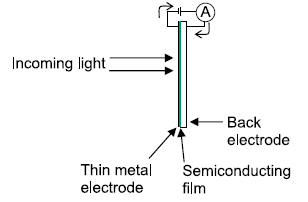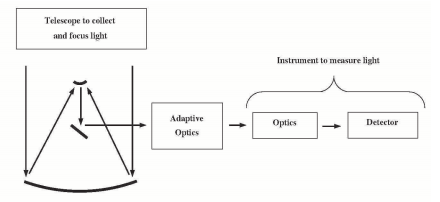Introduction
Astronomy is field of science which has important discoveries every time. These scientific achievements have been attributed by technological advancement. Several ways are used to detect photons but most users feel constrained by considerations ruggedness and inconvenience (King, 2015). However, astronomic have unique ways in which they approach fundamental performance level. Their main objective is how fast a sensor detects the elements in the environment. These performance attributes depend on a combination of detector characteristics including noise, quantum efficiency, and pixels elements in an array.
Detectors for space applications sense, track, distinguish, and decide both cold and hot objects that can either be close or very far, given scenarios such as daylight or shadow. With this ideal set of requirements, an ideal detector has optical signal and good frequency agility. A new era in modern infrared astronomy was established in 1965-1985, the first astronomical device to use an infrared detector occurred in 1985. These devices were small with reading noises of more than 1000 electrons (King, 2015). However, further developments have been made by the National Aeronautics and Space Administration (NASA) leading to the development of unique sensors and detectors for application in wide astronomical scopes.
Types of Detectors
Infrared Detectors
Sensors or detectors are devices that perceive or measure a physical property and responds to it. Detectors are photoconductive semiconducting materials like silicon with metal electrodes in both sides and they are used to establish the presence of electromagnetic field. Initially, Infrared detectors used silicon charge devices; however, silicon is not ideal because the detectors require low temperature that are needed by infrared sensors. Infrared detectors sensors are categorized into two: photon and thermal detectors. In wireless sensor networks, these sensors may be used for communication, distance, or angle measurement. The accuracy of these sensors makes them ideal for use in distance measuring by the astronomers.
Infrared detectors consist of infrared lead emitting diodes and photodiodes. Lead emitting diodes radiates infrared light, and the resistance of photodiode change depending on the amount of infrared radiation that is falling on them. During the direct incidence, the lead emitting diodes is placed in front of photodiodes, so the infrared will be directly sensed by the photodiode. Placing any object between them will prevent access of infrared signal to the receiver. Infrared detectors, therefore, can be classified into a photon, thermal and bolometer sensors.
Photon Detectors
Photon sensors count the light particles, they have metallic surface that absorbs the light particles and produces electrical field; Photon detectors show a selected wavelength depending on response per unit incidence radiation power. Photon detectors exhibit an excellent signal to noise performance and speedy response, ideal in much astronomical equipment (Basdevant & Rich, 2015). These detectors require a cryogenic substance for cooling, which is important to prevent the thermal generation of charge carriers.
A photovoltaic cell is composed of a layer of semiconductor such as silicon. It is placed located between two metallic electrodes. The two electrodes are transparent and very thin Photons are absorbed by the semiconductors thus forming electronics that are directly proportional to the number of photons absorbed.

Thermal Detectors
In thermal detectors, incident radiation is absorbed to charge temperature and some physical properties’, resulting in change. The sensor is located on the legs that are joined with the mask; the signal does not depend on the incident radiation’s photonic nature. Thus, the thermal sensors are generally wavelength-independent the signals dependent on the radiant power. These sensors are applicable in spectral areas that are inaccessible using photons detectors. They are also deployed in low-speed and low-dynamic ranges like optical power meters for lasers.
Thermal detector’s general operations include the following: They have a light absorber, thermally more or less insulated against the external environment, so that the temperature can rise when the incident light is absorbed. Absorbers of light have to be very strong for them to obtain maximum temperature rise for the detector’s highest sensitivity. They also have some temperature sensors, which either measures the absorber’s absolute temperature or the temperature difference between absorber and heat sink.
Application of Infrared Detectors in Astronomy
Infrared sensor (IR sensor) Infrared sensors are photo-based detectors that has been applied for various uses. There are multiple types of infra-red sensors: Tran’s missive and Reflective; in transmissive type, the infra-red detectors, which are usually the photodiode, are located adjustment to each other, when a body crosses between the photodiodes, the sensors detects the movement. A telescope focuses the light collected and reflect it for the ground based telescope.

Adaptive optics have been applied in many ground based telescopic sensors or detectors to navigate the vision. However, the major disadvantage of telescopes is that they are not ideal as they can only give good results in relatively bright objects. Telescope has been used in astronomy to study space and the solar system the technology has also been applied in military and other security bodies.
Astronomies investigate objects infrared portions of using optical detectors and digital detectors. Astronomers could benefit from the application of the infrared part of the spectrum because this would allow them to notice dark molecular clouds of gas and dust. This would be possible because infrared part makes a human eye see them glowing with radiated heat.
Advantages and Disadvantages of Infrared Detectors
Infrared detectors allow humans to view the heat an object emits. This is very important for astronomers to detect heat emitted by bodies like the galaxy and the stars. They also allow humans to view the wavelength of light that is not visible by the human eye. The use of infrared detectors has enabled human beings to develop sophisticated instruments such as telescopes that will have enables astronomies to venture more into space.
The use of infrared rays has been applied in the of field security by the help of astronomies. Systems such as metal detectors that uses infrared light are in great use today. Infrared rays are very penetrative and thus they can scan through an object and detect metal objects like guns and other dangerous weapons. Automatic door opening and alarm systems have also been developed by use of infrared sensors. Alarm systems uses the logic of two parallel rays when a body moves towards the rays, the rays are broken, and the alarm is activated.
One of the strengths of infrared detectors is scanning technology; ironically, it is the biggest weakness for infrared sensors. Infrared detectors do not use visible light; hence it can produce images that show different colors from the colors chosen. This can give out conflicting information that is inaccurate. Similarly, this technology cannot distinguish between near or obscuring objects when they have the same temperature. The described weak sides of infrared detectors imply that an observer will get only information on the objects’ temperature and will not receive any information on their remoteness if additional sensors are not applied.
Hence, the efficiency of infrared detectors is comparatively low (Capper & Elliott, 2013). In addition to that, the frequencies of infrared detectors are easily affected not only by solid objects but also by fog, rain, sunlight, magnetic metals, and other sensors (Pandey & Mishra, 2019). Therefore, infrared sensors cannot scan items located behind a wall and work appropriately on a foggy day.
Another significant disadvantage is that the use of infrared detectors can have medical complications. Apparently, infrared thermometers used in hospitals are not dangerous because of the weakness of the light. However, infrared light used in more complicated detectors than thermometers can be harmful to the eyes. Besides, when it is used in industrial measures uncontrolled other lights from electromagnetic spectrum such as gamma rays and X-rays can be emitted, and these rays are radioactive hence they are dangerous and can cause disease such as cancer.
Conclusion
Very high-performance infrared detectors are very common in astronomy in the late history. Sophisticated infrared sensors and architectures that is meant to fabric them has been developed. Most of these detectors have been applied in astronomy with other sectors such as the military and security personnel. Infrared detectors have been deployed in the astronomy field due to detect light that is not practically visible to the human eye. These detectors also have limitations; they cannot distinguish near similar objects with the same temperatures. Though these detectors are very advantageous they can cause medical problems and complications in the human body such as eye problems cancer.
References
Basdevant, J. L., & Rich, J. (2015). Fundamentals in nuclear physics: From atomic structure to cosmology. Springer Science & Business Media.
Capper, P., & Elliott, C. T. (Eds.). (2013). Infrared detectors and emitters: materials and devices (Vol. 8). Springer Science & Business Media.
King, D. A. (2015). Handbook of Archaeoastronomy and Ethnoastronomy. Springer Science+Business Media New York.
Pandey, M., & Mishra, G. (2019). Types of Sensor and Their Applications, Advantages, and Disadvantages. In Emerging Technologies in Data Mining and Information Security (pp. 791-804). Springer.